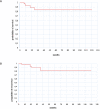Erectile function after partial penectomy for penile cancer
- PMID: 33620995
- PMCID: PMC7993948
- DOI: 10.1590/S1677-5538.IBJU.2019.0119
Erectile function after partial penectomy for penile cancer
Abstract
Purpose: To evaluate the erectile function in patients who underwent partial penectomy and identify factors associated with penile functional status.
Materials and methods: We identified patients who underwent partial penectomy due to penile cancer between 2009 and 2014. Clinical and pathological characteristics included patient age at the time of diagnosis, obesity, hypertension, dyslipidemia, diabetes, smoking, metabolic syndrome, Eastern Cooperative Oncology Group (ECOG) status, penile shaft length, tumor size, primary tumor stage (pT), clinical nodal status, and local recurrence. Erectile function was assessed prospectively with the International Index of Erectile Function (IIEF-5) at least 3 months after partial penectomy.
Results: A total of 81 patients met analysis criteria. At the diagnosis, the median age was 62 years (range from 30 to 88). Median follow-up was 17 months (IQR 7-36). Of total patients, 37 (45%) had T2 or higher disease. Clinically positive nodes were present in 16 (20%) patients and seven (8.6%) developed local recurrence. Fifty patients (62%) had erectile dysfunction (ED) after partial penectomy, 30% had moderate or severe erectile dysfunction scores. Patients with ED versus without ED were similar in baseline characteristics except for age, penile shaft length, and presence of inguinal adenopathy (p <0.05). Multivariate analysis using logistic regression confirmed that older patients, shorter penile shaft length, and clinically positive lymph node were significantly associated with ED.
Conclusion: Partial penectomy due to penile cancer provides adequate local control of the disease, however, proper counselling is important especially in relation to ED consequences. Preservation of penile length yields to more optimal erectile recovery.
Keywords: Amputation; Erectile Dysfunction; Penile Neoplasms.
Copyright® by the International Brazilian Journal of Urology.
Conflict of interest statement
None declared.
Figures
Comment in
-
Editorial Comment: Erectile function after partial penectomy for penile cancer.Int Braz J Urol. 2021 May-Jun;47(3):523-524. doi: 10.1590/S1677-5538.IBJU.2019.0119.1. Int Braz J Urol. 2021. PMID: 33620996 Free PMC article. No abstract available.
Similar articles
-
Effects of partial penectomy for penile cancer on sexual function: A systematic review.PLoS One. 2022 Sep 22;17(9):e0274914. doi: 10.1371/journal.pone.0274914. eCollection 2022. PLoS One. 2022. PMID: 36137121 Free PMC article.
-
Health-Related Quality of Life and Sexual Function in Patients Treated for Penile Cancer.Urol Int. 2018;101(3):351-357. doi: 10.1159/000491827. Epub 2018 Aug 27. Urol Int. 2018. PMID: 30149391
-
Sexual Function after Partial Penectomy: A Prospectively Study From China.Sci Rep. 2016 Feb 23;6:21862. doi: 10.1038/srep21862. Sci Rep. 2016. PMID: 26902397 Free PMC article.
-
Sexual outcomes after partial penectomy for penile cancer: results from a multi-institutional study.Asian J Androl. 2017 Jan-Feb;19(1):57-61. doi: 10.4103/1008-682X.168690. Asian J Androl. 2017. PMID: 26643562 Free PMC article.
-
New treatment options for erectile dysfunction in patients with diabetes mellitus.Drugs. 2004;64(23):2667-88. doi: 10.2165/00003495-200464230-00004. Drugs. 2004. PMID: 15537369 Review.
Cited by
-
Global outcomes and lessons learned in the management of Fournier's gangrene from high-volume centres: findings from a literature review over the last two decades.World J Urol. 2022 Oct;40(10):2399-2410. doi: 10.1007/s00345-022-04139-4. Epub 2022 Sep 4. World J Urol. 2022. PMID: 36059020 Review.
-
Effects of partial penectomy for penile cancer on sexual function: A systematic review.PLoS One. 2022 Sep 22;17(9):e0274914. doi: 10.1371/journal.pone.0274914. eCollection 2022. PLoS One. 2022. PMID: 36137121 Free PMC article.
-
Living in a rural area as a risk factor for worst outcomes in penile cancer.Int Braz J Urol. 2021 Nov-Dec;47(6):1259-1263. doi: 10.1590/S1677-5538.IBJU.2021.99.15. Int Braz J Urol. 2021. PMID: 34115455 Free PMC article. No abstract available.
-
Evaluation of Health-Related Quality of Life in Patients Receiving Treatment for Penile Cancer: A Single-Center Cross- Sectional Study.Asian Pac J Cancer Prev. 2023 Apr 1;24(4):1367-1371. doi: 10.31557/APJCP.2023.24.4.1367. Asian Pac J Cancer Prev. 2023. PMID: 37116160 Free PMC article.
-
Infertility highlighted in International Brazilian Journal of Urology.Int Braz J Urol. 2021 May-Jun;47(3):479-481. doi: 10.1590/S1677-5538.IBJU.2021.03.01. Int Braz J Urol. 2021. PMID: 33620993 Free PMC article. No abstract available.
References
-
- 1. Siegel RL, Miller KD, Jemal A. Cancer statistics, 2016. CA Cancer J Clin. 2016; 66:7-30. - PubMed
-
- 2. Christodoulidou M, Sahdev V, Houssein S, Muneer A. Epidemiology of penile cancer. Curr Probl Cancer. 2015; 39:126-36. - PubMed
-
- 3. Favorito LA, Nardi AC, Ronalsa M, Zequi SC, Sampaio FJ, Glina S. Epidemiologic study on penile cancer in Brazil. Int Braz J Urol. 2008; 34:587-91. - PubMed
-
- 4. Chipollini J, Yan S, Ottenhof SR, Zhu Y, Draeger D, Baumgarten AS, et at. Surgical management of penile carcinoma in situ: results from an international collaborative study and review of the literature. BJU Int. 2018; 121:393-8. - PubMed
-
- 5. Hakenberg OW, Compérat EM, Minhas S, Necchi A, Protzel C, Watkin N. EAU guidelines on penile cancer: 2014 update. Eur Urol. 2015; 67:142-50. - PubMed
MeSH terms
LinkOut - more resources
Full Text Sources
Other Literature Sources
Medical
Miscellaneous

